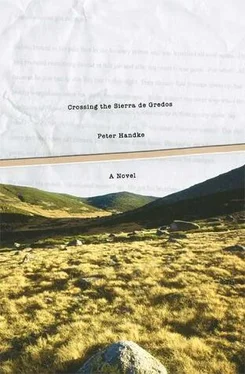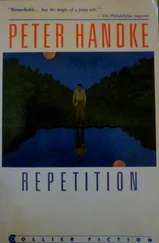On her property — the former stagecoach relay station and orchard — at the edge of the riverport city, she had once had an experience that presaged her interlude in Hondareda, an experience with a quince tree, known to her in one of the few remaining Sorbian words in her vocabulary as dunja , along with kwita .
That year the quince, aka dunja , had bloomed, with its inimitable white blossoms, shaped like small, shallow bowls and gleaming from amid the dense, dull-green foliage, but then not one single fruit had developed. And nevertheless she went out to the tree every morning that summer, and then also in the fall, and looked to see whether there was not at least one quince, no, dunja. As time passed, here and there in the yard next door, so much smaller and more shaded, that ineffable dunja green, later yellow, appeared again, together with those rounded forms that surpassed any apple or other tree-borne fruit, and the shimmering fuzz on the surface. Only, in her orchard, no matter how often she climbed the ladder and poked through the leaves: nothing, and today again nothing.
And nevertheless she had not ceased to be on the lookout and to search. Was it not possible that in the fork of a bough or elsewhere, concealed from sight, a dunja might be hiding? Yes, one day it would present itself to her eyes, a body, a curve, a fruit — with weight, volume, and fragrance among all the flat, odorless, and weightless leaves, which here and there were rounded, mimicking a fruit. And her looking would contribute to the fruit’s taking shape and its eventual appearance; would help bring forth the quince, the one quince on the tree. And if not, she, the experienced fruit thief, would simply take one from next door and attach it by a string or something to her tree — exclamation point!
And then, one morning in late fall, when the foliage had become sparse, crinkled, and often blackened, with yellow spots like the special Almanzor salamander up here, from a distance her gaze, without being intent on anything for a change, unexpectedly—“out of the blue,” the author’s suggestion — behind, between, no, in front of, next to, and especially above the salamandrine spots, encountered a form, a ball no larger than a wild apple — which in that spot, on the previously so empty and barren tree, created a sphere in which the entire tree, without any wind, and with the dunja lancets at a standstill, strangely rigid in their wilting, at the moment when she caught sight of the quince (“So there!”) seemed to be turning. In this fashion a second and a third fruit then appeared, one more meager and nondescript than the next, and she left them all hanging on the tree, to shrivel and turn wintry black.
And looking as a form of intervening, contributing, and inducing manifested itself again during her time in Hondareda, going far beyond such influencing of a plant. The observer had observed correctly when he spoke of the shapelessness or homeliness or chaotic ugliness of both the entire settlement in its layout and the individual hovels, “sleeping crates,” “pre-Promethean holes in the ground,” “termite mounds without termite architecture.” And yet he had not looked long enough, or often enough?
Had he ever stepped over a threshold and eaten, lived, and so forth with the inhabitants in a sense fundamentally different from that in which some other, particularly assiduous, travel writers “participate in the natives’ lives”? Not once — although his reports do attest that everywhere entry had been silently refused to him, despite the absence of any visible, physical barrier-threshold in front of the living-holes; and as a result, he, together with the other members of his team, instead of crossing a threshold in Hondareda considerately and like a polite guest, had blindly forced his way in and remained blind to the spaces and conditions inside, or had he, or perhaps not?
She, on the other hand, the unmistakably foreign woman — which did not mean outsider — discovered in this new settlement high in the mountains — which was a place of transition, and not only because of its proximity to the Candeleda Pass — a painstakingly worked-out, precisely defined, and, in the last analysis, positively artistic system of thresholds, or, in the inhabitants’ water-dominated vocabulary, locks? And once one’s eyes and all one’s senses caught on to this system, the apparently chaotic image of the settlement, seemingly mimicking the postglacial chaos of boulders scattered around without plan or rhythm, as well as the human habitations, acquired form (and forms) and relevance.
True, it was a correct observation that each route into the colony took an inconvenient and seemingly illogical course, involving twists and turns, and going around bends that without apparent reason led one far from one’s destination; even a path or rocky trail to the neighbor’s place directly across the way followed a seemingly needlessly roundabout detour. But these detours had been there from the beginning, before the inhabitants settled in and constructed their dwellings, had been laid out after his arrival by one camper to the next: a sign and indication of the mutual commitment to preserving distance between oneself and others, a polite measure precisely in these cramped quarters, perhaps an even more distinct signal of giving one’s fellow immigrant a wide berth, intended as a salutation: “I mean well by you!”
And it was from these original detours, established without much ado (or actually with much ado) between the new arrivals — perhaps prefigured for all of them in the human circulatory system — from this kind of both external and internal pre-tracery, then, that without much further effort the entire seemingly pointless network of diverging and deviating streets, alleys, and passageways had developed in the village of Hondareda.
And with some variations the same was true of the individual buildings, or the natural features that had simply been adapted for living, storage, parking, cellaring: the caves, the holes and niches, the clay pits; and equally true of the now abandoned huts of the hermits, a succession of whom had followed each other to the basin over the centuries, huts that on closer inspection turned out to have been altered in all sorts of ways and only from above appeared to have caved in; and likewise true of the one-time “king’s refuge,” which only an outsider would perceive as a threatful (was that word still in use?) mountain fortress in ruins, and which, to be sure, continued to be marked on all maps of the Sierra by a small black triangle (= ruin), but in reality had meanwhile been rebuilt by the Hondarederos step by step as something else entirely, starting deep inside this obsolete castle, where, invisible to observers, a new cornerstone had been laid: as the seat of government of the — self-declared? nothing up there is declared, and precisely that is part of the international Hondareda problem — enclave, the seat of government hidden away in what still looks like a pile of stones and beams from the former royal refuge, and can be reached only with difficulty from the inhabited basin below: far, far removed from this government seat or center in the sky-high wilderness, at least sixty times sixty hammer throws or ten to thirteen sonic seconds away.
No matter over which thresholds in the Hondareda region you step or let yourself be sluiced or carried into the center of the habitations, and not only the geometric center: everywhere you will find yourself enclosed by that sphere that categorically refused to be recognizable from the outside. Even in a mere shack, even in a culvert-like structure resembling a segment of a pipeline (which upon your entry turns out nonetheless to be heated and equipped with bull’s-eye windows like a cruise ship), you immediately encounter the quince, as it were, the dunja, both in the singular and the plural, the fruit; the flavor and color radiate from the living area into the other spaces, and out into the open.
Читать дальше












